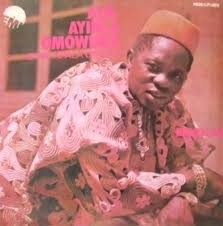
For the Record: AYINLA OMOWURA AND THE UNTOLD STORY

It took a few weeks after before fans could come to terms with the departure of a man who to some was the enfant terrible of Apala music; who, with an admixture of a quartet musical instruments of Sekere maracas, akuba, Iya-ilu and agidigbo, attacked societal ills in his characteristic acidic tongue. Omowura, though illiterate, projected the image of an ombudsman to the oppressed.
Born in 1933 in Itoko, Abeokuta, Omowura, as early as when he was in his teens, was said to have been apprenticed to his father’s blacksmithry trade. Unconfirmed sources said that while growing up, Omowura interspersed this early childhood vocation with acting as political thug to some politicians of the time. He was also said to have once been a driver.
By the early 70s, along with other Apala prodigies of the time like Haruna Ishola (who reportedly invented the genre), S. Aka, Ligali Mukaiba, Yusuff Olatunji, Kasumu Adio, S.K.B Ajao-Oru, Fatai Ayilara, Ojubanire Ajape Saka Tewogbade and others, he had successfully transformed not only Apala but his fortunes as well, into a genre of music that was not strictly the pastime of the Yoruba lower class as it was hitherto perceived. He recorded 22 albums. Omowura held society spellbound by his song, occasionally infusing his Egba dialect as a musical motif, delivered in a rich voice that was perhaps accentuated by his rumored passion for cannabis.
In his social critic garb, Omowura was the scourge of the then emerging fad of women bleaching (Volume 15, Oro kan je mi logun) where he compared, sarcastically, the body of a woman who bleaches with that of the frog and wondered why the white man does not, comparatively, flee after the black skin. His songs were also the nemesis of ladies who changed husbands’ houses like a chameleon changes color (Pansaga ranti ojo ola) where he espoused the concept of the Onibambashi — most likely a barroom argot — classification of such women. Paradoxically, Omowura was said to be the toast of married women beer salon operators in his Abeokuta and Mushin homes and on several occasions, had to engage their husbands in physical, as well as musical scuffles to assert his supremacy.
One of such was his justification of women running beer salons in his “Oro mi dori o dori” track which became almost a national anthem for fans of this bohemian Yoruba musician. In a very scurrilous attack which made him and his song almost like leprosy to feminists for his perceived anti-women biases, Omowura attacked societal malaise and projected a high moral universe. He sang with an authority of being in possession of a musical inspiration and mastery of his trade that verged on blatant arrogance. He tells his competitors, for example, that until the weaverbird gains easy access to the liquid inside the coconut pod could any one of them attempt to outshine his genius and that he is the alujonnu elere (musical gnome), having surpassed them all.
The high point for Omowura, who sang on virtually every domestic dislocation of his household, was in the late 70’s when he bought a brand new Mercedes Benz car. For this, a track entitled Merzi tun de, heralding the arrival of the musical behemoth on the music scene graced one of his albums and, of course as usual, coated with a caustic diatribe against his enemies who thought he had reached the twilight of his musical inspiration.
As a commentator on issues of the contemporary society, Omowura reeled out innumerable tracks either commending government policies, excoriating bad ones or warning society on ills strung round certain governmental and individual acts. In E fara m’Omobolaji, Brigadier Mobolaji Johnson’s tenement rate policy in Lagos state received his dissection and applause. He enjoined Lagosians not to kick against this laudable government policy but give support to Johnson and didactically, detail by detail, tutored his listeners on the process of the payment of the tenement rate.
In another breath, Omowura sang about the 1976 Udoji salary increment (Vol 7) and like an informed commentator that he was, urged that the largesse be extended to the private sector (e je ka san’wo Udoji na fawon private companies).
His view of a musician was one who fully participated in the cumbersome process of dialogue and interrogation of the complex situational issues of society.
When General Murtala Mohammed was assassinated, Omowura delved into a soul-inspiring, tear-jerking elegy (Dimka, eni o pa o!…) wherein he outlined the fallen soldier’s sparkling qualities while excoriating General and Colonel Iliya Bisala and Buka Sukar Dimka for plotting the fine soldier’s elimination. When the Obasanjo military government thereafter decided to have Murtala’s picture and name embossed on the Twenty Naira note and named the Lagos international airport after him, these again formed the subjects of his musical engagements.
He was one of the few musicians who paid tribute to a fallen colleague of theirs, Ayinde Bakare, who was found murdered after some days of frenetic search for him (Vol. 3).
Perhaps if he had not been a musician, Omowura would have been a footballer. His love for the round leather game was reflected in his commentaries on some football matches played in the country that he obviously watched. The 1972 and 1974 Challenge Cup matches (which later became the titles of an album and a track in Vols. 3 and 6 respectively) between Mighty Jet and Bendel Insurance, as well as one between Enugu Rangers and Mighty Jet engaged his attention where he recaptured the events on the turf by doing a re-rendition of Eyimba eyi!, Rangers’ Supporters’ Club song, to cheer their clubside.
Among others, FESTAC ’77, a cultural event that attracted participants from all over the world, also attracted the musical commentary of Ayinla Omowura, also known by his fans as the Eegunmongaji or Anigilaje. As a prominent worshipper of the Yoruba god of iron, Ogun, wherein his notoriety and that of his musical ensemble got its renown, the Egba-born musician saw the cultural event as another avenue of pouring libation to the gods, this time by government.
Commentaries that also engaged the attention of Omowura were the 1973 census, wave of robberies, change of driving path from left to right, the rumoured banning of wearing of lace materials for the rumoured belief that it courted armed robbery and several others. When, for example, Nigeria changed her currency, the musical crusader and commentator thought it fit to educate his long list of fans on the worth and look of the Naira denominations.
Like every other musician, women made up the coatings of his world. Those who knew him while alive spoke of an Haji Costly (one of his aliases), decked in the latest lace material in town, with a hanging, dangling necklace doing a swing on his neck, and a member of his band permanently stationed beside him to invite over any lady in whom he had a philandering interest.
Incidentally, however, his songs come across as anti-feminist as he hardly perceived anything of good in the womenfolk, except seeing them as commodities. For example, in his popular track entitled Enirobi simi, ibi a ba(Vol 15), a song which he used to dispel rumours making the round that he had been kidnapped by his enemies, in gutter-like acidic outrage against those he termed the peddlers of the rumour, Omowura easily took a shuttle to the maternal homes of the ‘rumour peddlers’ and categorically asserted that such people’s mothers were the ones who were suffering from a fit of malady.
Frustrated by the truancy of his first son (now late, Akeem Omowura), in Omo afekosofo, he sang about a child who rubbishes the joy of education offered him by a father who is ever ready to foot his education which is his joy of tomorrow. Education, he said, is more enduring than a wait on parents’ wealth. He reminded the prodigal son that his parents could abruptly go on a troubadour of no return for which the parents would give no prior notice and that truancy does not pay.
Like a prophet, Omowura went on his journey without giving notice. He spoke about Death’s morbidly dark complexion, dilating eyes and the prolific strikes with his club (iku oponu olodi ab’ara dudu hoho!) as well as the certainty of everyone’s death. He sang so masterly about death in an existentialist manner that reminds one of existential philosophers’ treatments of death, especially the void of Martin Heidegger’s Sorge.
Omowura was very fetish like many musicians of his time. Incantations and curses lace virtually all his songs and husbands cross with their wives are recorded to see his LPs as temporary ego victories over such wives at home. He told any competing musician who had the gumption to belittle him on the bandstand to prepare to take his hands off life’s menu as such a defiant musician was done with the meals of this world and should prepare to start eating with the dead at the cemetery(Olorin to ba f’oju dimi lode, jije, mimu e tan nile aye).
His dirge at the death of Seriki Amodemaja, an Egba chief and prominent Ogboni fraternity chieftain, was a masterpiece in its own right. So also is the elegy to Akanni Fatai, also known as Bolodeoku. Both songs are spiced with his characteristic eulogy of the dead and philosophical interrogation of the concept, process and inscrutable essence of death. In the elegy to Amodemaja, Omowura mocks as well as dramatizes the inactivity and solemnity that follow death and the pain of the departure of a loved one.
Coupled with another masterpiece celebration of life of another Ogboni chieftain in a track entitled Shifu Lawal Omopupa Oluwo,(Vol 6) with the cadence of his celebration of the edan,an insignia of Ogboni people and the masterly infusion he made of the music and dance of the Ogboni into this particular track, critics come to the conclusion that Omowura was himself a member of the cult.
Critics also locate the incident of his death in his perceived over-indulgence with violence and belief in the rescue potential of the talisman. An unconfirmed account of his death says that Ayinla Agbe’japa Oba – the Tortoise Priest of Oba, a section of Egbaland, whom he paid obeisance to in virtually all his albums; whom he, in one of his tracks, annoyingly equated with God by ascribing some omnipotent epithets to (Ogbagba ti n gba ara adugbo lowo ewu!) – who was also his spiritual consultant and advisor, his babalawo, had warned him of an impending bloodbath that week and forbade him going out for any musical show. Sure that danger only lurked at a musical engagement, Omowura had reportedly refrained from honoring any show that week but had gone out, this particular evening, with a friend to a beer parlor for relaxation.
Knowing the built-up animosity between him and his former band manager, Bayewu, who resigned from the band allegedly without handing over his official CD bike which Omowura had bought for him, this version of his death continues, a fan was reported to have rushed to meet him at the beer parlour to inform him that Bayewu was also at a beer joint not far off. An effusion of anger had reportedly seized Omowura as he drove hastily off to accost Bayewu. In the cause of the exchange of umbrage, the manager had reportedly hit his boss with a beer glass cup on the head, so mild that it ordinarily shouldn’t have led to death. Omowura had reportedly slumped, his tongue zooming out mysteriously. Another version of his death says Bayewu and Omowura were feuding over a woman friend and that the former had intentionally murdered his boss. The account’s defence of this conclusion was that, both of them had been handed frighteningly protective phials and concoction, with an incision done on Omowura’s head, which forbade blood touching his head. Bayewu was hanged by the state some years later.
Omowura picked quarrels easily with fellow musicians of the time as ferns are picked in a plantation. He was known to have at one time or the other feuded with Dauda Epo Akara, Ayinde Barrister, Haruna Ishola (whom he later did a track to pay tribute to as the numero unoamong musicians all over (ninu elere gbogbo agbaye pata o, Ishola mo fear e ju), among several others others. It was indeed the feud with Barrister that later served as the foundation of the prolonged musical enmity between Barrister and Kollington Ayinla, a known musical surrogate of Omowura’s. Kollington was so committed to the Omowura enigma that his first known album was used to take a swipe at Fatai Olowonyo, Omowura’s Egba kinsman who also engaged in a bitterly violent musical war of supremacy with the late Apala exponent. They were both reported to have also engaged in physical battles on several occasions. Thus, when Omowura was assassinated, Kollington not only took on the form, tenor and pattern of Omowura’s music, but inherited his adversaries too, one of whom was Barrister.
In fact, most of the sharp-tongued tracks in Omowura’s albums a few years to his death, were references to Olowonyo who, as it were, seemed to be well out of the class of the late musician in the trade of gutter language. For example, in a track entitled E lewure wole, Olowonyo literally took Omowura to the cleaners, alleging that the Toyota car he had just bought was acquired from the proceeds of theft of neighbours’ sheep and goats, among other pungent punches that indeed visibly hurt Omowura. Alao Adewole, Omowura’s lead drummer, in the group’s next album, had to prologue the leading track with a talking drum symphonic reply to Olowonyo’s tirade, asking the world to, e wo man yi to so pe mo gbe’wure (look at this man who claimed I stole goats!). Omowura himself later came up to tell the world to cultivate a fighting arena for him and his challenger, so as to determine who was the champion in his E fa’won were sile (Volume 6). He said those poking fun at him for purchasing the Toyota did not even possess the bike of the palm wine-taper!
Olowonyo thereafter went personal in his attacks on Omowura, deriding eegunmongaji’s dark, tobacco-stained teeth and drooping lips. Stung by this jab, Omowura was said to have contacted a dentist who bleached his tobacco-stained teeth. As a follow-up, Olowonyo again did another LP where he acknowledged that indeed, Omowura had found an answer to his burnt teeth but demanded where he would find answers to his flabby lips. In a solemn, escapist reply, Omowura then told Olowonyo that he who had found favour in the sight of the world, the world would in turn overlook his inadequacies (eni aye n fe o larun kan lara). Rumours had it that, frustrated at this barrage of mud-slinging, Omowura had eventually gone talismanic against Olowonyo, culminating in his popular track, A ti fi’koko de won monle (I have shrouded his essence in a black pot), which fans saw as a spiritual binding of Olowonyo, who, thereafter, even after Omowura’s death, had hardly produced an album, almost forty years after. Such was the nature of the musical supremacy squabbles of the time. A few years before his death, Omowura had gone to observe the holy pilgrimage in Mecca. It was said that it was during this pilgrimage that he and Olowonyo decided to mend fences.
Omowura also, along the line, feuded with and sang to abuse his lead drummer, Adewole, in a track entitled Nibo lowa ta o ri lode? (Vol. 15) where he urged Adewole to send an application to him to become his cook rather than attempt to establish another musical outfit. He even claimed that the LP Adewole managed to produce was so inferior that it could not be marketed, necessitating him hiding the sleeves underneath his agbada in shame. Omowura, however, later celebrated the resolution of the rift in a track entitled Ipari ija Ayinla pelu Adewole (Vol 18) while blaming his enemies for the prolongation of the tiff and their desire to have it fester.
Omowura’s classic tribute to Yusuff Olatunji after the demise of the respected musician is considered today as, not only a strong philosophical composition unique only to Omowura, but equipped with all the trappings of a human quest to know the logic of death’s strike. Omowura wondered, for example, in the vinyl, how, with the famed resistance and melodious goje flute of Olatunji, death could be so callous, unfeeling and insulated from good rhythms that it could ever pull down a big mansion that the death of Olatunji represented to the music world.
Despite his talent and inspiration, Omowura was blessed with a crop of equally talented composers who made his job of singing a lot easier and he acknowledged their composition in his songs. Men like Bashir Igbore, Razaq Tuntun, Aremu Orifogo, Ateni Se Mess and others acted as guiding spirits to Omowura and he generously and liberally tapped from their compositions, with acknowledgements.
Omowura lamented his illiteracy and tried to rise above its limitations. In 25 X 40 for example, he tried to impress it on his listeners that his unlettered disposition could not vitiate his intelligence. The desire to one day travel abroad (abi London ti e wi ti ya?, bo s’America a jo n lo ni, etc) featured prominently in his songs, so also a fervent wish to be around to witness the good of his children which he expressed in very deep Yoruba (isu omo a jinna fun wa je). Unfortunately, he never lived to witness both.
In spite of his limitations and foibles, Omowura remains a great musical beacon in Yorubaland and the eternality of his advocacies and evergreen texture of his songs are beginning to be seen by a Yoruba world that shut its mind off his melody, musical scholarship and social criticism, simply because of his low class, illiteracy and obsessive identification with the rejects of society.
Dr. Festus Adedayo




